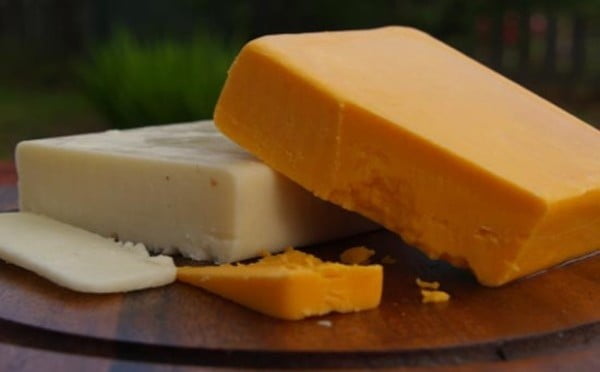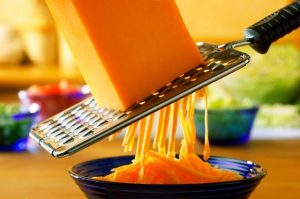Cheddar is recognized as the healthiest cheese

Of all the cheeses, Cheddar stands out not only for its taste but also for its certain health benefits. What makes it so good? According to nutritionists, Cheddar cheese contains a high concentration of essential nutrients,
in particular, high-quality protein and calcium, which are very beneficial for health. This is why it is so important to consume dairy products daily, and Cheddar cheese is the best of all dairy products.
And it doesn't matter what form you eat it in, whether it's soup or Cheddar sauce. You'll get all the nutrients it contains.
Although the anti-cancer properties of cheese have not yet been fully studied, its ability to reduce the likelihood of tooth decay has already been proven. Cheddar stimulates the flow of saliva, which neutralizes the acid that causes tooth decay.
Cheddar is virtually lactose free., making it an ideal source of calcium and many other nutrients found in milk for people who have difficulty digesting lactose, or milk sugar.
Nutritionists advise choosing recipes for all sorts of dishes with Cheddar cheese or simply sprinkling it on vegetables or pasta. Everything will be healthy and tasty.

HOMEMADE CREAM CHEESE FOR DESSERTS AND SNACKS
NOTE: It is considered useful, but there is a BUT! Neurologists advise people suffering from headaches to limit their consumption of this cheese. The substance tyramine contained in cheddar, which is formed during the decomposition of amino acids, has toxic properties and leads to such undesirable phenomena as vasoconstriction, excitation and inhibition of the nervous system, which can provoke a migraine attack.
There is only one conclusion: EVERYTHING IS GOOD IN MODERATION, THEN IT WILL BE BENEFICIAL!)
INFORMATION:
Cheddar cheese is a hard English cow's milk cheese that was first produced in the distant twelfth century in the village of Cheddar in Somerset. This cheese was named after this place, and the process of its production is cheddarization.
The cheese mass is elastic and has a sharp nutty taste with a pleasant sourness. Its color is predominantly creamy, but yellow and orange Cheddar can be found (thanks to the natural annatto dye).
The cheese wheels are not small - up to 37 kilograms in weight, and this is not the limit - in 1840, a half-ton cheese wheel was made, which was sent as a wedding gift to Queen Victoria.
How is Cheddar Cheese Made?
Cheddar can be made from either pasteurized or raw cow's milk, although it was originally made only from sheep or goat's milk. The process of making this cheese is extremely simple, like all ingenious things. Cow's milk is curdled, separated from the whey, and wrapped in cloth to allow the liquid to drain. The cheese is then left to mature for three to six months, and sometimes Cheddar languishes in the cellar for several years.
Cheddar cheese has many varieties, each with its own unique taste. By varying the aging time, you can make Cheddar with a delicate creamy taste or with a sharp, spicy taste. Each eater chooses based on their gastronomic preferences.
The English are very fond of this spicy cheese, it is very popular throughout Europe. Since Cheddar does not have a protected name, this word can be used to refer to any cheese made using this technology. Thus, in most European stores you can find American Cheddar, which has been produced in the USA for more than a century and a half.
Cheddar can be used as a stand-alone snack, or it can be added to various dishes to improve their taste. Thus, the English often add Cheddar to sauces, omelettes, casseroles, sprinkle grated cheese on grilled vegetables, stewed vegetables, fish, meat, croutons, sandwiches, etc. In English cuisine, you can find many old and modern recipes that feature Cheddar.
Cheddar is served with port, beer or wine, and goes well with fruits, especially bananas.
Composition of Cheddar Cheese
It should be said that this cheese is not much different in composition from other types of hard cheeses made from cow's milk. Vitamins, minerals, amino acids, a large amount of calcium, phosphorus, and fats, so you should not lean on Cheddar and eat more than a couple of slices a day, so as not to harm your figure.
Vitamin PP (Niacin equivalent) (PP) 6.1 mg
Vitamin E (TE) (E (TE)) 0.6 mg
Vitamin D (D) 0.7 mcg
Vitamin C (C) 1 mg
Vitamin B12 (cobalamins) (B12) 1.4 mcg
Vitamin B9 (folic acid) (B9) 19 mcg
Vitamin B6 (pyridoxine) (B6) 0.1 mg
Vitamin B2 (riboflavin) (B2) 0.38 mg
Vitamin B1 (thiamine) (B1) 0.05 mg
Vitamin A (RE) (A (RE)) 277 mcg
Beta-carotene 0.16 mg
Vitamin PP (PP) 0.1 mg
Vitamin A (A) 0.25 mg
Minerals
Manganese (Mn) 0.1 mg
Copper (Cu) 70 mcg
Zinc (Zn) 4 mg
Iron (Fe) 1 mg
Sulfur (S)235 mg
Phosphorus (P)545 mg
Potassium (K)116 mg
Sodium (Na) 850 mg
Magnesium (Mg)54 mg
Calcium (Ca) 1000 mg
Source: http://kulinariya.lichnorastu.ru/syir-chedder-priznan-samyim-poleznyim/